Abstract
The roles of mutational and recombinational processes in the diversification of the exon encoding the antigen binding site in the murine major histocompatibility complex class II gene Ab were assessed by phylogenetic analysis of allelic nucleotide sequences. A total of 46 alleles of Ab exon 2 from 12 Mus species or subspecies and 2 Rattus species were sequenced after amplification by the polymerase chain reaction. Reliable allelic genealogies could not be determined by phylogenetic analyses, due to extensive homoplasy in the data set. This homoplasy results from the shuffling of polymorphisms between alleles by recombinational processes, indicating that polymorphisms in the antigen binding site encoded by Ab are generated by a combination of two processes. First, the accumulation of point mutations has produced highly divergent polymorphic sequence motifs in five regions of Ab exon 2, each encoding a portion of the binding site. Some of these motifs have persisted as polymorphisms in rodents since before the divergence of mouse and rat (greater than 10 million years ago). The second process mediating Ab diversification involves the shuffling of these polymorphic sequence motifs into numerous allelic combinations by repeated intraexonic recombination. Site-specific hyperrecombinational mechanisms are not involved in this process within the exon. We postulate that these mechanisms continuously generate new Ab alleles with highly divergent binding sites from which alleles with advantageous antigen-binding properties are selectively maintained by some form of balancing selection.
Full text
PDF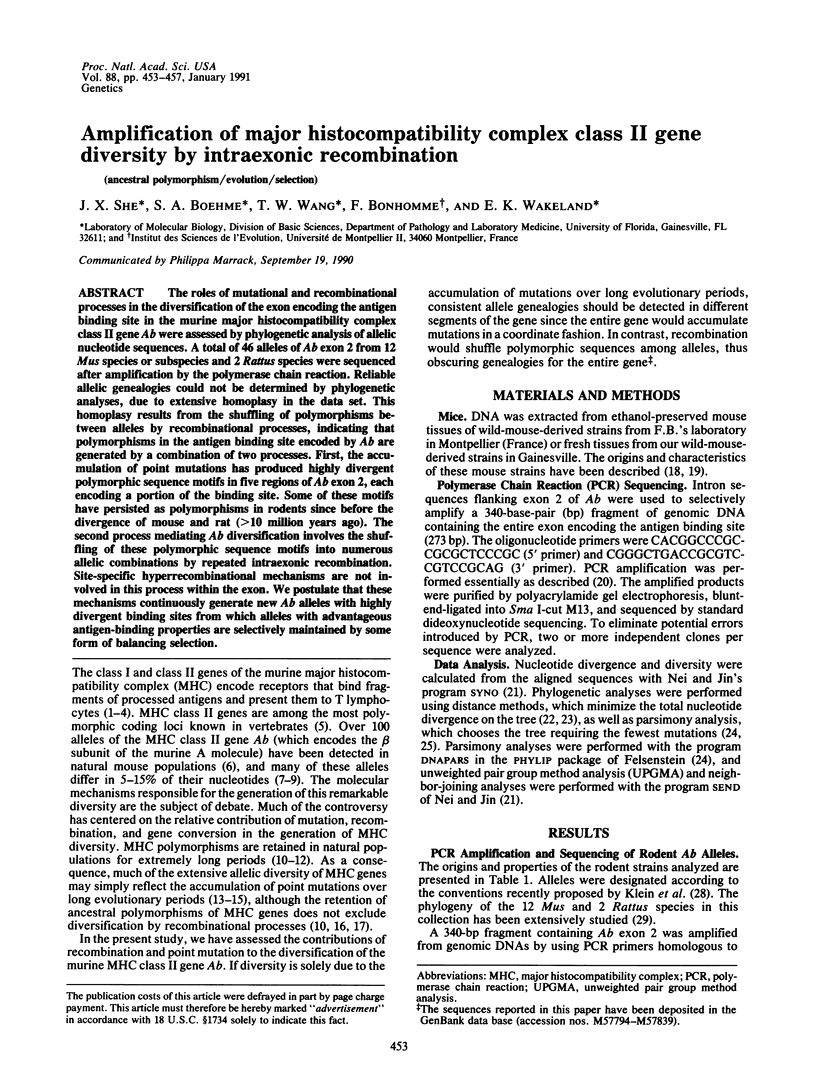
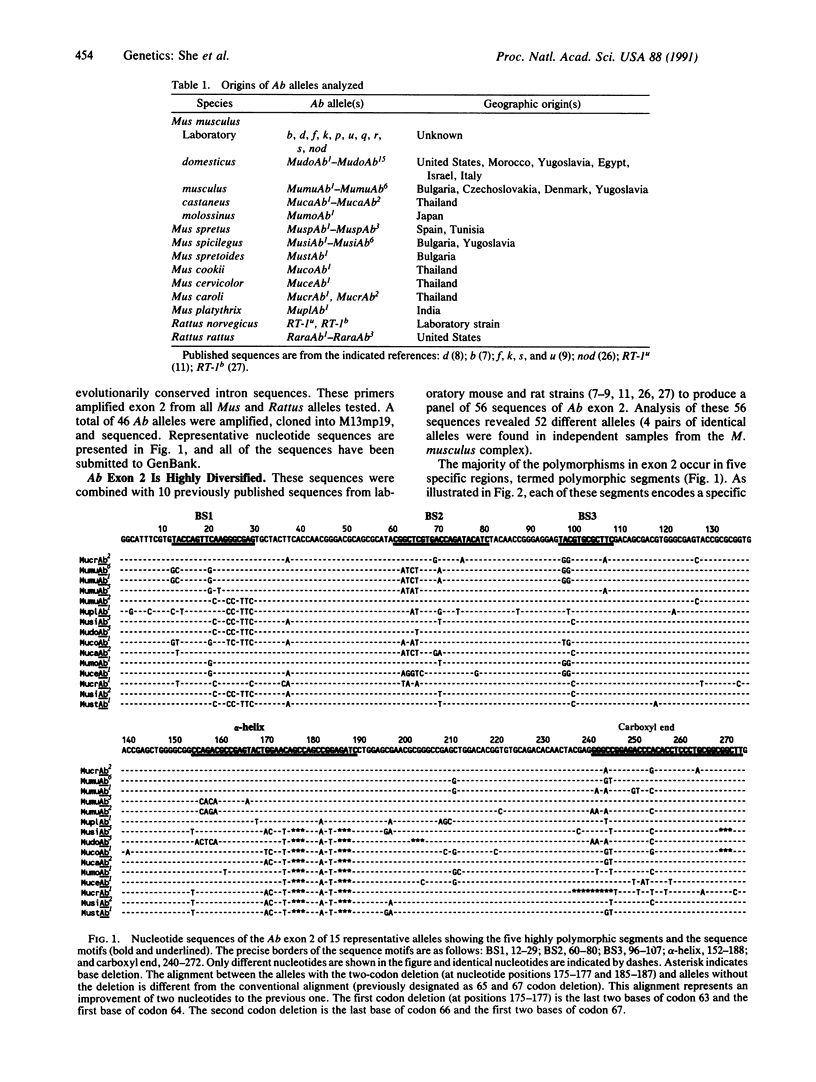
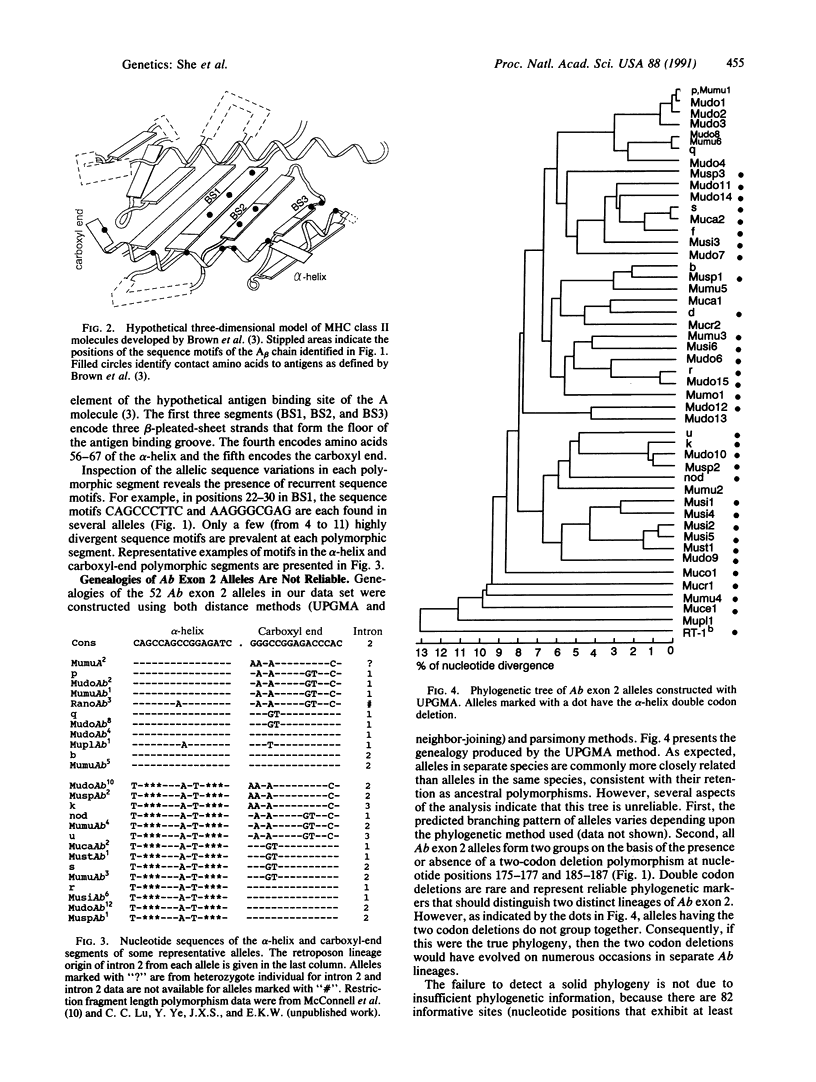
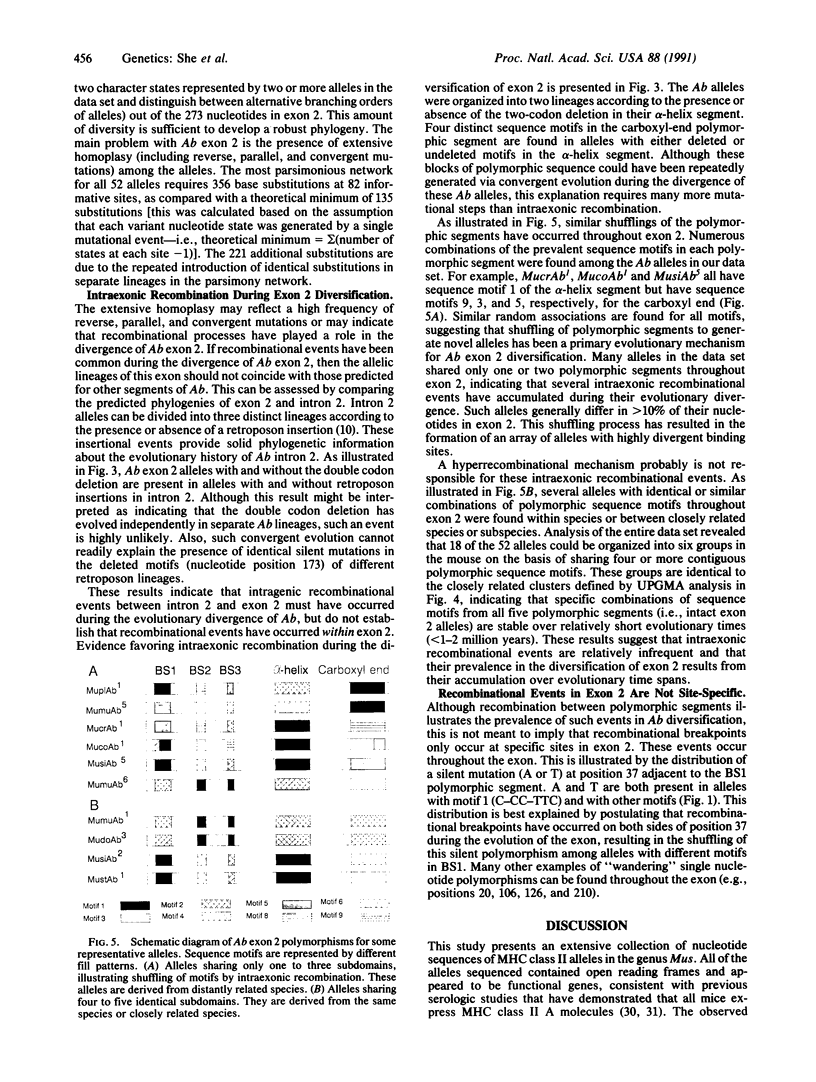
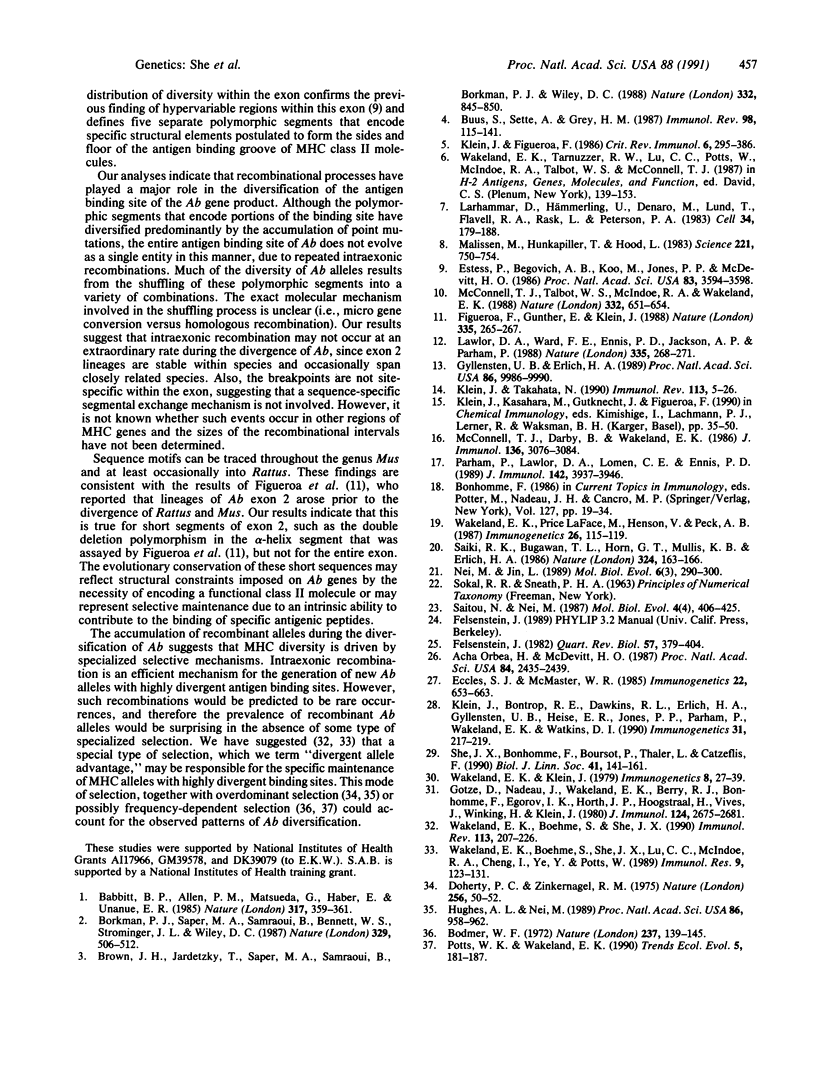
Images in this article
Selected References
These references are in PubMed. This may not be the complete list of references from this article.
- Acha-Orbea H., McDevitt H. O. The first external domain of the nonobese diabetic mouse class II I-A beta chain is unique. Proc Natl Acad Sci U S A. 1987 Apr;84(8):2435–2439. doi: 10.1073/pnas.84.8.2435. [DOI] [PMC free article] [PubMed] [Google Scholar]
- Babbitt B. P., Allen P. M., Matsueda G., Haber E., Unanue E. R. Binding of immunogenic peptides to Ia histocompatibility molecules. 1985 Sep 26-Oct 2Nature. 317(6035):359–361. doi: 10.1038/317359a0. [DOI] [PubMed] [Google Scholar]
- Bjorkman P. J., Saper M. A., Samraoui B., Bennett W. S., Strominger J. L., Wiley D. C. Structure of the human class I histocompatibility antigen, HLA-A2. Nature. 1987 Oct 8;329(6139):506–512. doi: 10.1038/329506a0. [DOI] [PubMed] [Google Scholar]
- Bodmer W. F. Evolutionary significance of the HL-A system. Nature. 1972 May 19;237(5351):139–passim. doi: 10.1038/237139a0. [DOI] [PubMed] [Google Scholar]
- Brown J. H., Jardetzky T., Saper M. A., Samraoui B., Bjorkman P. J., Wiley D. C. A hypothetical model of the foreign antigen binding site of class II histocompatibility molecules. Nature. 1988 Apr 28;332(6167):845–850. doi: 10.1038/332845a0. [DOI] [PubMed] [Google Scholar]
- Buus S., Sette A., Grey H. M. The interaction between protein-derived immunogenic peptides and Ia. Immunol Rev. 1987 Aug;98:115–141. doi: 10.1111/j.1600-065x.1987.tb00522.x. [DOI] [PubMed] [Google Scholar]
- Doherty P. C., Zinkernagel R. M. Enhanced immunological surveillance in mice heterozygous at the H-2 gene complex. Nature. 1975 Jul 3;256(5512):50–52. doi: 10.1038/256050a0. [DOI] [PubMed] [Google Scholar]
- Eccles S. J., McMaster W. R. DNA sequence analysis of a rat RT1 class II A beta gene. Immunogenetics. 1985;22(6):653–663. doi: 10.1007/BF00430314. [DOI] [PubMed] [Google Scholar]
- Estess P., Begovich A. B., Koo M., Jones P. P., McDevitt H. O. Sequence analysis and structure-function correlations of murine q, k, u, s, and f haplotype I-A beta cDNA clones. Proc Natl Acad Sci U S A. 1986 Jun;83(11):3594–3598. doi: 10.1073/pnas.83.11.3594. [DOI] [PMC free article] [PubMed] [Google Scholar]
- Figueroa F., Günther E., Klein J. MHC polymorphism pre-dating speciation. Nature. 1988 Sep 15;335(6187):265–267. doi: 10.1038/335265a0. [DOI] [PubMed] [Google Scholar]
- Gyllensten U. B., Erlich H. A. Ancient roots for polymorphism at the HLA-DQ alpha locus in primates. Proc Natl Acad Sci U S A. 1989 Dec;86(24):9986–9990. doi: 10.1073/pnas.86.24.9986. [DOI] [PMC free article] [PubMed] [Google Scholar]
- Götze D., Nadeau J., Wakeland E. K., Berry R. J., Bonhomme F., Egorov I. K., Hjorth J. P., Hoogstraal H., Vives J., Winking H. Histocompatibility-2 system in wild mice. X. Frequencies of H-2 and Ia antigens in wild mice from Europe and Africa. J Immunol. 1980 Jun;124(6):2675–2681. [PubMed] [Google Scholar]
- Hughes A. L., Nei M. Nucleotide substitution at major histocompatibility complex class II loci: evidence for overdominant selection. Proc Natl Acad Sci U S A. 1989 Feb;86(3):958–962. doi: 10.1073/pnas.86.3.958. [DOI] [PMC free article] [PubMed] [Google Scholar]
- Klein J., Bontrop R. E., Dawkins R. L., Erlich H. A., Gyllensten U. B., Heise E. R., Jones P. P., Parham P., Wakeland E. K., Watkins D. I. Nomenclature for the major histocompatibility complexes of different species: a proposal. Immunogenetics. 1990;31(4):217–219. doi: 10.1007/BF00204890. [DOI] [PubMed] [Google Scholar]
- Klein J., Figueroa F. Evolution of the major histocompatibility complex. Crit Rev Immunol. 1986;6(4):295–386. [PubMed] [Google Scholar]
- Klein J., Takahata N. The major histocompatibility complex and the quest for origins. Immunol Rev. 1990 Feb;113:5–25. doi: 10.1111/j.1600-065x.1990.tb00034.x. [DOI] [PubMed] [Google Scholar]
- Larhammar D., Hammerling U., Denaro M., Lund T., Flavell R. A., Rask L., Peterson P. A. Structure of the murine immune response I-A beta locus: sequence of the I-A beta gene and an adjacent beta-chain second domain exon. Cell. 1983 Aug;34(1):179–188. doi: 10.1016/0092-8674(83)90148-4. [DOI] [PubMed] [Google Scholar]
- Lawlor D. A., Ward F. E., Ennis P. D., Jackson A. P., Parham P. HLA-A and B polymorphisms predate the divergence of humans and chimpanzees. Nature. 1988 Sep 15;335(6187):268–271. doi: 10.1038/335268a0. [DOI] [PubMed] [Google Scholar]
- Malissen M., Hunkapiller T., Hood L. Nucleotide sequence of a light chain gene of the mouse I-A subregion: A beta d. Science. 1983 Aug 19;221(4612):750–754. doi: 10.1126/science.6410508. [DOI] [PubMed] [Google Scholar]
- McConnell T. J., Darby B., Wakeland E. K. Restriction fragment-length polymorphisms of class II gene sequences in mice expressing minor structural variants of I-Ak and I-Ap. J Immunol. 1986 Apr 15;136(8):3076–3084. [PubMed] [Google Scholar]
- McConnell T. J., Talbot W. S., McIndoe R. A., Wakeland E. K. The origin of MHC class II gene polymorphism within the genus Mus. Nature. 1988 Apr 14;332(6165):651–654. doi: 10.1038/332651a0. [DOI] [PubMed] [Google Scholar]
- Nei M., Jin L. Variances of the average numbers of nucleotide substitutions within and between populations. Mol Biol Evol. 1989 May;6(3):290–300. doi: 10.1093/oxfordjournals.molbev.a040547. [DOI] [PubMed] [Google Scholar]
- Parham P., Lawlor D. A., Lomen C. E., Ennis P. D. Diversity and diversification of HLA-A,B,C alleles. J Immunol. 1989 Jun 1;142(11):3937–3950. [PubMed] [Google Scholar]
- Saiki R. K., Bugawan T. L., Horn G. T., Mullis K. B., Erlich H. A. Analysis of enzymatically amplified beta-globin and HLA-DQ alpha DNA with allele-specific oligonucleotide probes. Nature. 1986 Nov 13;324(6093):163–166. doi: 10.1038/324163a0. [DOI] [PubMed] [Google Scholar]
- Saitou N., Nei M. The neighbor-joining method: a new method for reconstructing phylogenetic trees. Mol Biol Evol. 1987 Jul;4(4):406–425. doi: 10.1093/oxfordjournals.molbev.a040454. [DOI] [PubMed] [Google Scholar]
- Wakeland E. K., Boehme S., She J. X. The generation and maintenance of MHC class II gene polymorphism in rodents. Immunol Rev. 1990 Feb;113:207–226. doi: 10.1111/j.1600-065x.1990.tb00042.x. [DOI] [PubMed] [Google Scholar]
- Wakeland E. K., Price-LaFace M., Henson V., Peck A. B. Production of 35 H-2 homozygous strains from wild mice. Immunogenetics. 1987;26(1-2):115–119. doi: 10.1007/BF00345465. [DOI] [PubMed] [Google Scholar]




